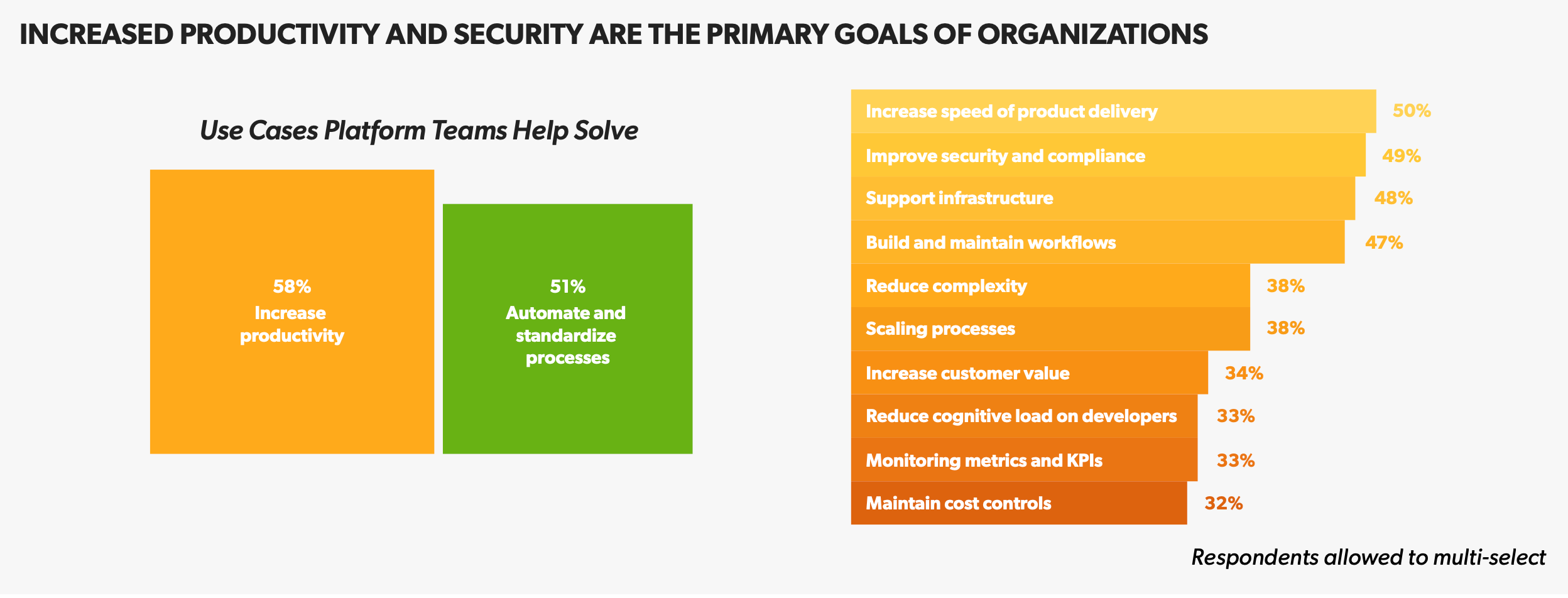Blog
March 26, 2024
Platform Engineering Metrics & KPIs to Measure Whether or Not Your Platform is Working
Platform Engineering,
How to & Use Cases
Platform engineering metrics and/or platform engineering KPIs (Key Performance Indicators) can help us measure the success of this evolving approach and its impact on DevOps. According to our 2024 State of DevOps Report: The Evolution of Platform Engineering — 43% of organizations report that they have had a platform team from 3-5 years already. With this maturity, it’s important to measure what’s working and what isn’t working using the same indicators of success across the board.
With this information, you can assess your own platform engineering approach and answer the question — how does my organization stack up compared to other similar organizations implementing this approach?
What are the Most Important Platform Engineering Metrics?
From our research, the top three most critical platform engineering metrics are increased speed of product delivery, improved security and compliance, and supported infrastructure.
Let’s look at survey data from our 2024 State of DevOps report to better understand how organizations rank their platform engineering goals. Our data comes from nearly 500 respondents at organizations around the world, all working with or on platform engineering teams with varying levels of maturity.
We can assume that meeting all these goals is important, but increased productivity and security are the top priorities:
 Back to top
Back to top
How to Measure the Top Platform Engineering Metrics
From the broader goals listed above, let’s examine specific markers of measurement for each, so you can better understand if you’re meeting or exceeding KPIs.
Increased Speed of Product Delivery
- Deployment Frequency & Lead Time — How often are features being deployed? What's the time it takes for a change to go from code commit to production? These metrics indicate development velocity and platform stability. Frequent, low-risk deployments indicate a healthy development environment.
- Mean Time to Resolution (MTTR) — This metric measures the average time that it takes for your team to resolve incidents. A low MTTR signifies that your platform is resilient and can quickly recover from issues.
- Developer Productivity — As we found in this year’s report, happy and productive developers are key to a platform's success. While it’s hard to happiness as a metric, you still can track metrics like code churn (AKA unnecessary code changes) and feature completion rates to get a peek into overall developer efficiency.
Improved Security and Compliance
- Reduced Incident Volume & Severity — The number and severity of incidents that occur on your platform provide insights into its overall health. A decrease in incidents signifies improvements in stability and reliability.
- Continuous Compliance — Enforcing and remaining in compliance by enforcing compliance as code is one way to improve your security posture. With a platform like Puppet, you have full visibility into your level of compliance. When problems need to be addressed, you’ll receive a notification so you can quickly remediate them.
- Resolution Speed — When a vulnerability is found, how quickly are your teams able to address it, without the need to audit and enforce compliance manually? The measure of how much time you saved before and after implementing a platform is a strong indicator that your processes are working.
Dive into all of our great platform engineering resources in our content hub
Supported Infrastructure
- Platform Adoption — How widely is your platform being used across the organization? High adoption indicates that developers find value in the tools and services offered.
- Standardization — 51% of respondents said that platform teams help them automate and standardize processes. Measuring your time saved through automation is just another KPI that Continuous Delivery for Puppet Enterprise can provide through its Activity Report.
Each of these three categories really measure success across an entire organization, but you might also consider metrics that are specific to a particular role. In this example, we will cite some of the top benefits that developers receive from platform engineering:
- Increased productivity (50%)
- Better quality of software (40%)
- Reduced lead time for deployment (36%)
- More stable applications (36%)
“Productivity” appears again as a term that can broadly cover time, team effort, and cost savings. For both developers and the organization itself, it’s important to get things done without a lot of back and forth, hiccups, or constraints. At the forefront of self-service, Platform Engineering is well-positioned to make these metrics happen.
Back to topDeveloping a Platform Engineering KPI Plan
From our 2024 report, we did not see one KPI that worked for everyone and acted as a “silver bullet” to solve platform engineering. Metrics are a great way to track progress and identify areas to improve, and you’ll want to think of them as such vs. a strict performance metric.
What does platform engineering look like for you? How mature is your platform, and is it effectively addressing productivity? Here are a few more questions to consider as you build a plan:
How productive (and happy!) are your developers? Track metrics like lead time for deployment, number of deployments per unit time, and developer satisfaction via surveys.
How broadly has your platform been adopted? Measure the number of teams actively using your platform, the rate of feature adoption, and developer engagement in training sessions.
How reliable is your platform? Monitor system uptime, incident resolution times, and the number of security vulnerabilities identified and addressed.
How many resources are you using to manage your platform? Keep an eye on key infrastructure metrics like CPU and memory usage, to ensure the best possible resource allocation and cost efficiency. For instance, cloud costs can add up — you might want to use more reserved instances once you understand your base usage.
One of our recommendations from the report is to consider a platform team evangelist who will not only gain buy-in from leadership but can also highlight and demonstrate the platform’s value to other teams. If someone is managing these platform engineering KPIs, they should also be tasked with sharing those results.
41% of multi-option respondents said that platform engineering “needs a greater understanding of the needs of internal users.” A platform team evangelist can act as a bridge, letting organizations know what is working and what needs to change.
Learn more about the state of platform engineering today, with data and expert analysis that can help you build a stronger platform. Download the full, free report:
